Observation and Analysis of Child Development through Play Activities
VerifiedAdded on 2022/10/19
|7
|2469
|50
AI Summary
This document provides observations and analysis of child development through play activities. It includes references to developmental domains such as physical, social, cognitive, and language. Theoretical perspectives such as Piaget's Cognitive Development and Bowlby's Attachment Theory are also discussed. The document suggests future learning possibilities for inclusion in the curriculum.
Contribute Materials
Your contribution can guide someone’s learning journey. Share your
documents today.
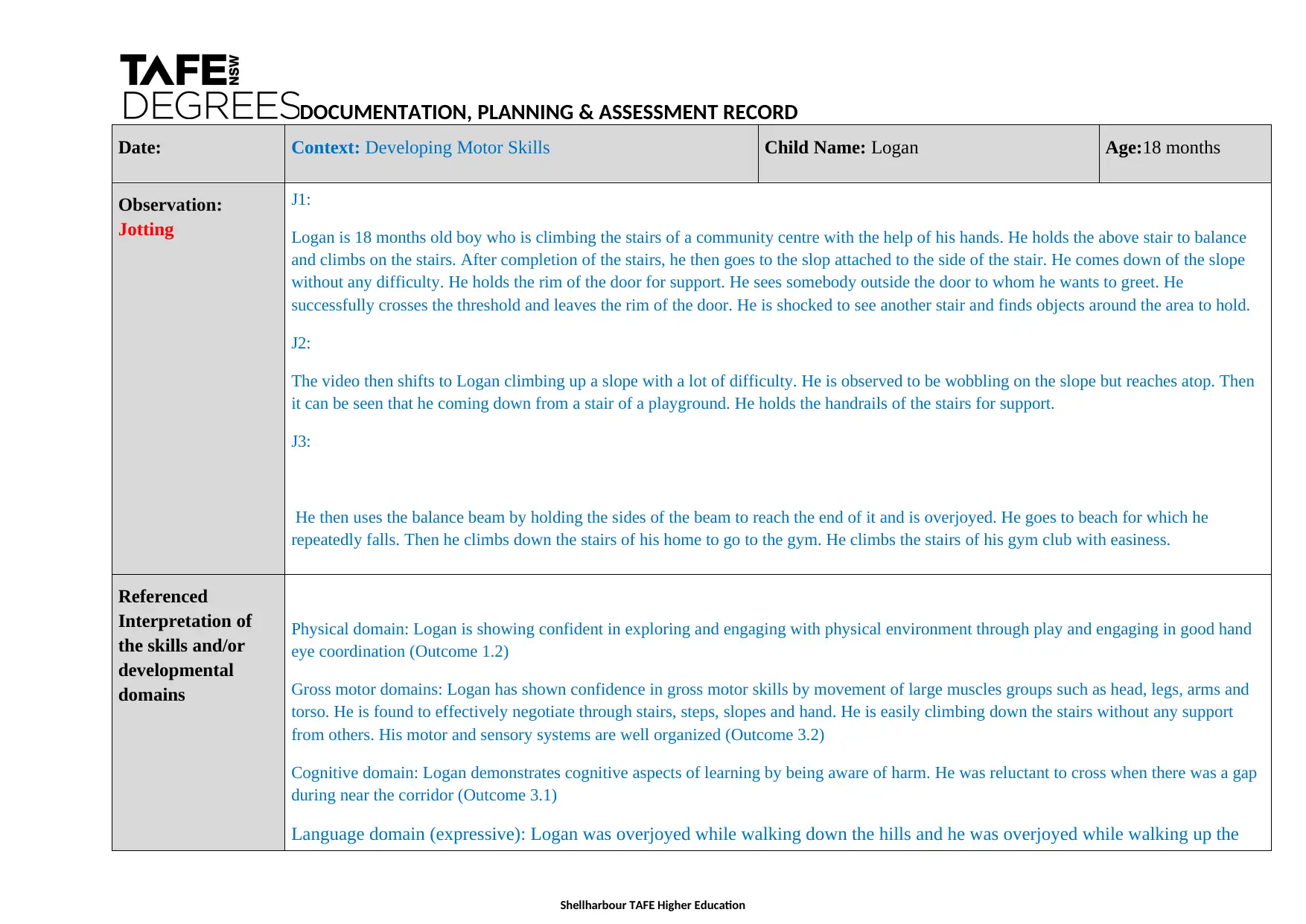
DOCUMENTATION, PLANNING & ASSESSMENT RECORD
Date: Context: Developing Motor Skills Child Name: Logan Age:18 months
Observation:
Jotting
J1:
Logan is 18 months old boy who is climbing the stairs of a community centre with the help of his hands. He holds the above stair to balance
and climbs on the stairs. After completion of the stairs, he then goes to the slop attached to the side of the stair. He comes down of the slope
without any difficulty. He holds the rim of the door for support. He sees somebody outside the door to whom he wants to greet. He
successfully crosses the threshold and leaves the rim of the door. He is shocked to see another stair and finds objects around the area to hold.
J2:
The video then shifts to Logan climbing up a slope with a lot of difficulty. He is observed to be wobbling on the slope but reaches atop. Then
it can be seen that he coming down from a stair of a playground. He holds the handrails of the stairs for support.
J3:
He then uses the balance beam by holding the sides of the beam to reach the end of it and is overjoyed. He goes to beach for which he
repeatedly falls. Then he climbs down the stairs of his home to go to the gym. He climbs the stairs of his gym club with easiness.
Referenced
Interpretation of
the skills and/or
developmental
domains
Physical domain: Logan is showing confident in exploring and engaging with physical environment through play and engaging in good hand
eye coordination (Outcome 1.2)
Gross motor domains: Logan has shown confidence in gross motor skills by movement of large muscles groups such as head, legs, arms and
torso. He is found to effectively negotiate through stairs, steps, slopes and hand. He is easily climbing down the stairs without any support
from others. His motor and sensory systems are well organized (Outcome 3.2)
Cognitive domain: Logan demonstrates cognitive aspects of learning by being aware of harm. He was reluctant to cross when there was a gap
during near the corridor (Outcome 3.1)
Language domain (expressive): Logan was overjoyed while walking down the hills and he was overjoyed while walking up the
Shellharbour TAFE Higher Education
Date: Context: Developing Motor Skills Child Name: Logan Age:18 months
Observation:
Jotting
J1:
Logan is 18 months old boy who is climbing the stairs of a community centre with the help of his hands. He holds the above stair to balance
and climbs on the stairs. After completion of the stairs, he then goes to the slop attached to the side of the stair. He comes down of the slope
without any difficulty. He holds the rim of the door for support. He sees somebody outside the door to whom he wants to greet. He
successfully crosses the threshold and leaves the rim of the door. He is shocked to see another stair and finds objects around the area to hold.
J2:
The video then shifts to Logan climbing up a slope with a lot of difficulty. He is observed to be wobbling on the slope but reaches atop. Then
it can be seen that he coming down from a stair of a playground. He holds the handrails of the stairs for support.
J3:
He then uses the balance beam by holding the sides of the beam to reach the end of it and is overjoyed. He goes to beach for which he
repeatedly falls. Then he climbs down the stairs of his home to go to the gym. He climbs the stairs of his gym club with easiness.
Referenced
Interpretation of
the skills and/or
developmental
domains
Physical domain: Logan is showing confident in exploring and engaging with physical environment through play and engaging in good hand
eye coordination (Outcome 1.2)
Gross motor domains: Logan has shown confidence in gross motor skills by movement of large muscles groups such as head, legs, arms and
torso. He is found to effectively negotiate through stairs, steps, slopes and hand. He is easily climbing down the stairs without any support
from others. His motor and sensory systems are well organized (Outcome 3.2)
Cognitive domain: Logan demonstrates cognitive aspects of learning by being aware of harm. He was reluctant to cross when there was a gap
during near the corridor (Outcome 3.1)
Language domain (expressive): Logan was overjoyed while walking down the hills and he was overjoyed while walking up the
Shellharbour TAFE Higher Education
Secure Best Marks with AI Grader
Need help grading? Try our AI Grader for instant feedback on your assignments.
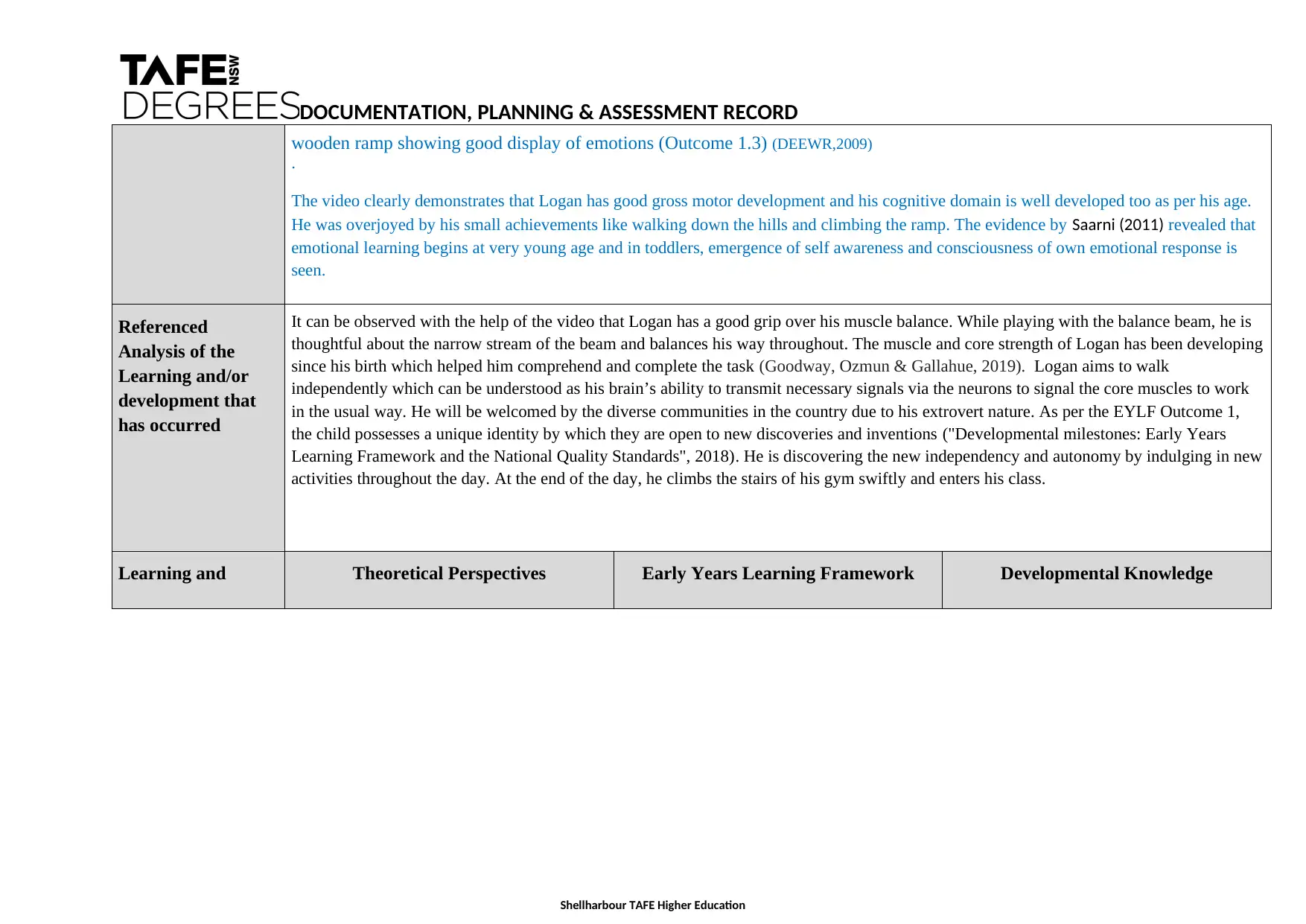
DOCUMENTATION, PLANNING & ASSESSMENT RECORD
wooden ramp showing good display of emotions (Outcome 1.3) (DEEWR,2009)
.
The video clearly demonstrates that Logan has good gross motor development and his cognitive domain is well developed too as per his age.
He was overjoyed by his small achievements like walking down the hills and climbing the ramp. The evidence by Saarni (2011) revealed that
emotional learning begins at very young age and in toddlers, emergence of self awareness and consciousness of own emotional response is
seen.
Referenced
Analysis of the
Learning and/or
development that
has occurred
It can be observed with the help of the video that Logan has a good grip over his muscle balance. While playing with the balance beam, he is
thoughtful about the narrow stream of the beam and balances his way throughout. The muscle and core strength of Logan has been developing
since his birth which helped him comprehend and complete the task (Goodway, Ozmun & Gallahue, 2019). Logan aims to walk
independently which can be understood as his brain’s ability to transmit necessary signals via the neurons to signal the core muscles to work
in the usual way. He will be welcomed by the diverse communities in the country due to his extrovert nature. As per the EYLF Outcome 1,
the child possesses a unique identity by which they are open to new discoveries and inventions ("Developmental milestones: Early Years
Learning Framework and the National Quality Standards", 2018). He is discovering the new independency and autonomy by indulging in new
activities throughout the day. At the end of the day, he climbs the stairs of his gym swiftly and enters his class.
Learning and Theoretical Perspectives Early Years Learning Framework Developmental Knowledge
Shellharbour TAFE Higher Education
wooden ramp showing good display of emotions (Outcome 1.3) (DEEWR,2009)
.
The video clearly demonstrates that Logan has good gross motor development and his cognitive domain is well developed too as per his age.
He was overjoyed by his small achievements like walking down the hills and climbing the ramp. The evidence by Saarni (2011) revealed that
emotional learning begins at very young age and in toddlers, emergence of self awareness and consciousness of own emotional response is
seen.
Referenced
Analysis of the
Learning and/or
development that
has occurred
It can be observed with the help of the video that Logan has a good grip over his muscle balance. While playing with the balance beam, he is
thoughtful about the narrow stream of the beam and balances his way throughout. The muscle and core strength of Logan has been developing
since his birth which helped him comprehend and complete the task (Goodway, Ozmun & Gallahue, 2019). Logan aims to walk
independently which can be understood as his brain’s ability to transmit necessary signals via the neurons to signal the core muscles to work
in the usual way. He will be welcomed by the diverse communities in the country due to his extrovert nature. As per the EYLF Outcome 1,
the child possesses a unique identity by which they are open to new discoveries and inventions ("Developmental milestones: Early Years
Learning Framework and the National Quality Standards", 2018). He is discovering the new independency and autonomy by indulging in new
activities throughout the day. At the end of the day, he climbs the stairs of his gym swiftly and enters his class.
Learning and Theoretical Perspectives Early Years Learning Framework Developmental Knowledge
Shellharbour TAFE Higher Education
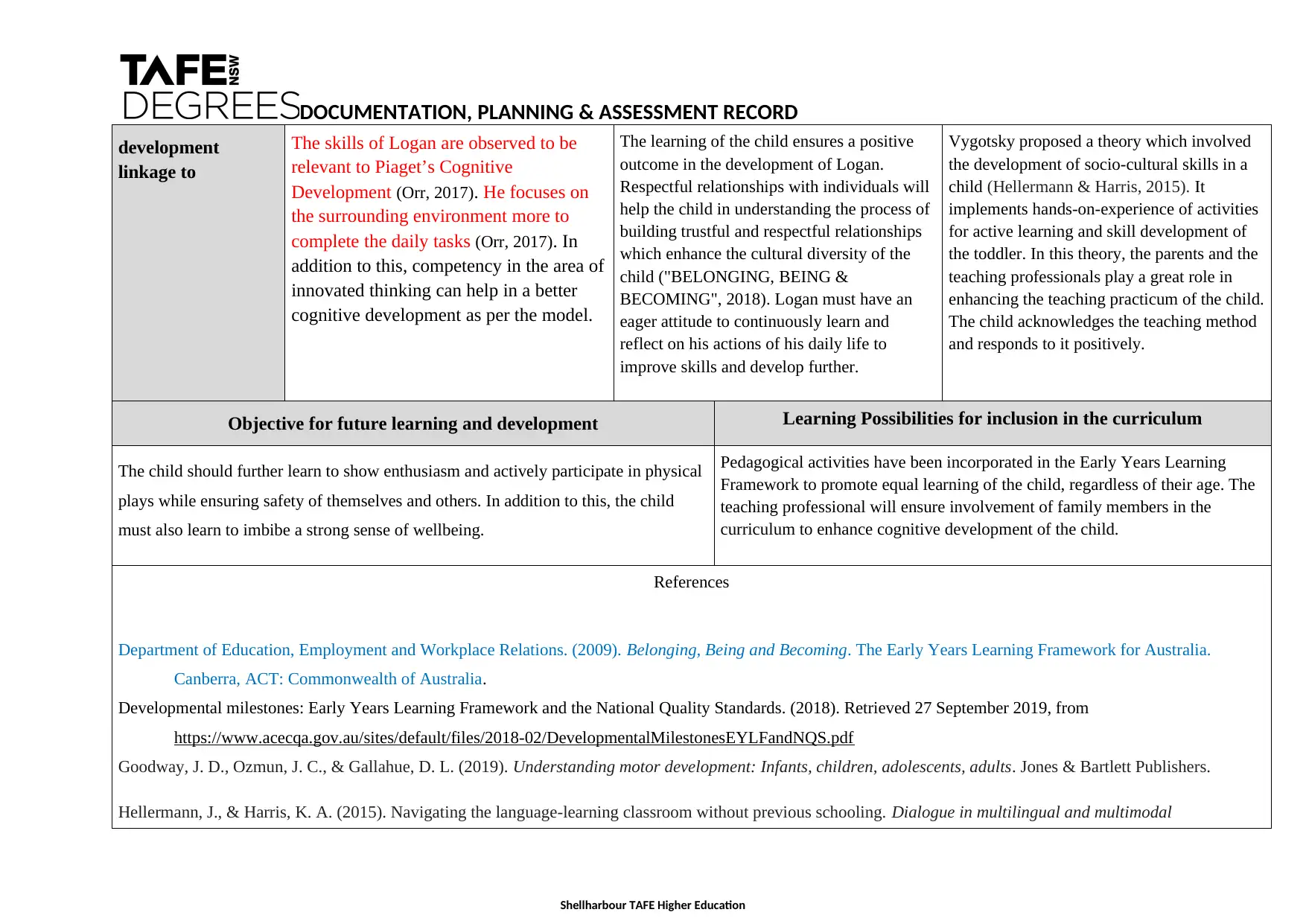
DOCUMENTATION, PLANNING & ASSESSMENT RECORD
development
linkage to
The skills of Logan are observed to be
relevant to Piaget’s Cognitive
Development (Orr, 2017). He focuses on
the surrounding environment more to
complete the daily tasks (Orr, 2017). In
addition to this, competency in the area of
innovated thinking can help in a better
cognitive development as per the model.
The learning of the child ensures a positive
outcome in the development of Logan.
Respectful relationships with individuals will
help the child in understanding the process of
building trustful and respectful relationships
which enhance the cultural diversity of the
child ("BELONGING, BEING &
BECOMING", 2018). Logan must have an
eager attitude to continuously learn and
reflect on his actions of his daily life to
improve skills and develop further.
Vygotsky proposed a theory which involved
the development of socio-cultural skills in a
child (Hellermann & Harris, 2015). It
implements hands-on-experience of activities
for active learning and skill development of
the toddler. In this theory, the parents and the
teaching professionals play a great role in
enhancing the teaching practicum of the child.
The child acknowledges the teaching method
and responds to it positively.
Objective for future learning and development Learning Possibilities for inclusion in the curriculum
The child should further learn to show enthusiasm and actively participate in physical
plays while ensuring safety of themselves and others. In addition to this, the child
must also learn to imbibe a strong sense of wellbeing.
Pedagogical activities have been incorporated in the Early Years Learning
Framework to promote equal learning of the child, regardless of their age. The
teaching professional will ensure involvement of family members in the
curriculum to enhance cognitive development of the child.
References
Department of Education, Employment and Workplace Relations. (2009). Belonging, Being and Becoming. The Early Years Learning Framework for Australia.
Canberra, ACT: Commonwealth of Australia.
Developmental milestones: Early Years Learning Framework and the National Quality Standards. (2018). Retrieved 27 September 2019, from
https://www.acecqa.gov.au/sites/default/files/2018-02/DevelopmentalMilestonesEYLFandNQS.pdf
Goodway, J. D., Ozmun, J. C., & Gallahue, D. L. (2019). Understanding motor development: Infants, children, adolescents, adults. Jones & Bartlett Publishers.
Hellermann, J., & Harris, K. A. (2015). Navigating the language-learning classroom without previous schooling. Dialogue in multilingual and multimodal
Shellharbour TAFE Higher Education
development
linkage to
The skills of Logan are observed to be
relevant to Piaget’s Cognitive
Development (Orr, 2017). He focuses on
the surrounding environment more to
complete the daily tasks (Orr, 2017). In
addition to this, competency in the area of
innovated thinking can help in a better
cognitive development as per the model.
The learning of the child ensures a positive
outcome in the development of Logan.
Respectful relationships with individuals will
help the child in understanding the process of
building trustful and respectful relationships
which enhance the cultural diversity of the
child ("BELONGING, BEING &
BECOMING", 2018). Logan must have an
eager attitude to continuously learn and
reflect on his actions of his daily life to
improve skills and develop further.
Vygotsky proposed a theory which involved
the development of socio-cultural skills in a
child (Hellermann & Harris, 2015). It
implements hands-on-experience of activities
for active learning and skill development of
the toddler. In this theory, the parents and the
teaching professionals play a great role in
enhancing the teaching practicum of the child.
The child acknowledges the teaching method
and responds to it positively.
Objective for future learning and development Learning Possibilities for inclusion in the curriculum
The child should further learn to show enthusiasm and actively participate in physical
plays while ensuring safety of themselves and others. In addition to this, the child
must also learn to imbibe a strong sense of wellbeing.
Pedagogical activities have been incorporated in the Early Years Learning
Framework to promote equal learning of the child, regardless of their age. The
teaching professional will ensure involvement of family members in the
curriculum to enhance cognitive development of the child.
References
Department of Education, Employment and Workplace Relations. (2009). Belonging, Being and Becoming. The Early Years Learning Framework for Australia.
Canberra, ACT: Commonwealth of Australia.
Developmental milestones: Early Years Learning Framework and the National Quality Standards. (2018). Retrieved 27 September 2019, from
https://www.acecqa.gov.au/sites/default/files/2018-02/DevelopmentalMilestonesEYLFandNQS.pdf
Goodway, J. D., Ozmun, J. C., & Gallahue, D. L. (2019). Understanding motor development: Infants, children, adolescents, adults. Jones & Bartlett Publishers.
Hellermann, J., & Harris, K. A. (2015). Navigating the language-learning classroom without previous schooling. Dialogue in multilingual and multimodal
Shellharbour TAFE Higher Education
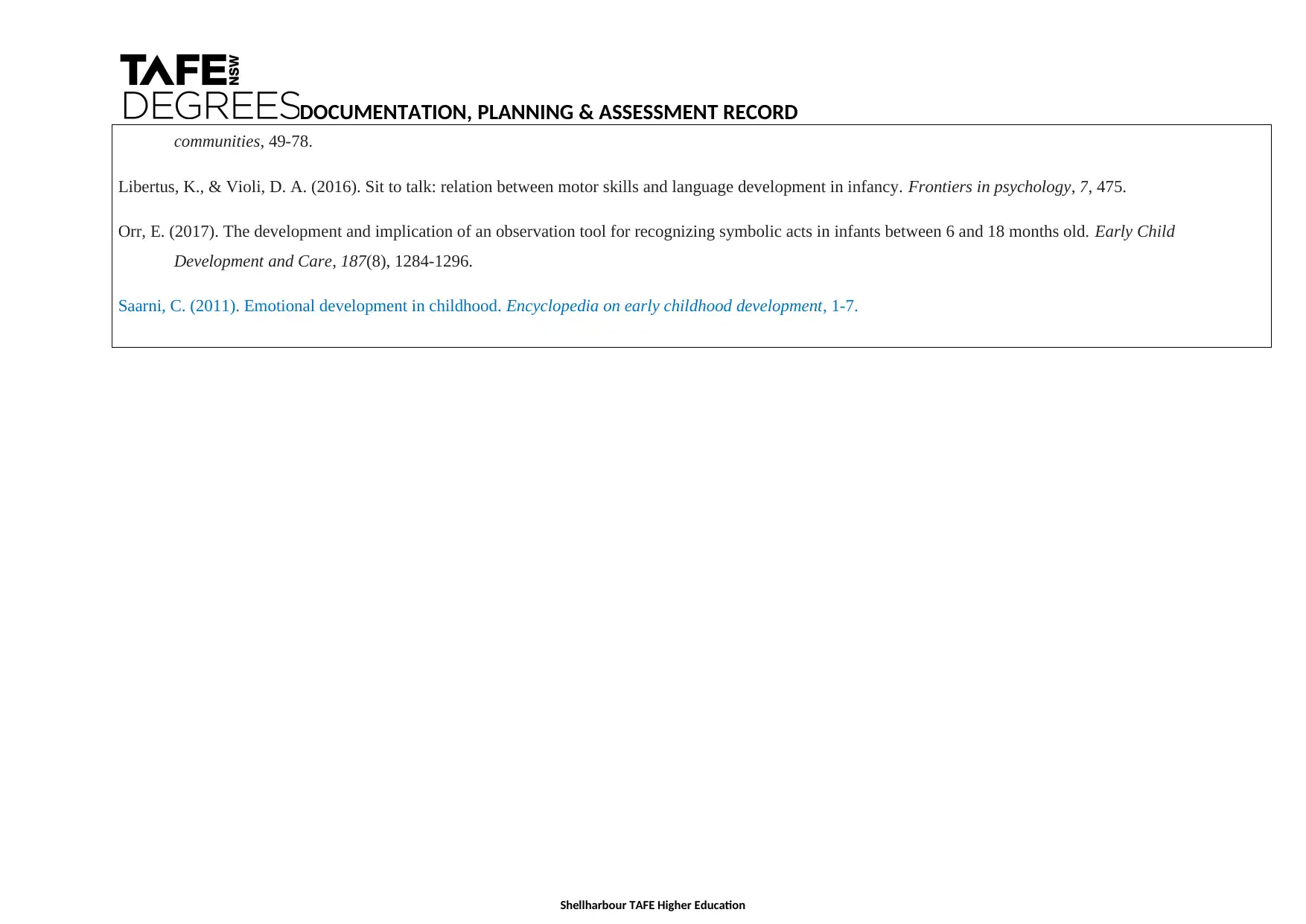
DOCUMENTATION, PLANNING & ASSESSMENT RECORD
communities, 49-78.
Libertus, K., & Violi, D. A. (2016). Sit to talk: relation between motor skills and language development in infancy. Frontiers in psychology, 7, 475.
Orr, E. (2017). The development and implication of an observation tool for recognizing symbolic acts in infants between 6 and 18 months old. Early Child
Development and Care, 187(8), 1284-1296.
Saarni, C. (2011). Emotional development in childhood. Encyclopedia on early childhood development, 1-7.
Shellharbour TAFE Higher Education
communities, 49-78.
Libertus, K., & Violi, D. A. (2016). Sit to talk: relation between motor skills and language development in infancy. Frontiers in psychology, 7, 475.
Orr, E. (2017). The development and implication of an observation tool for recognizing symbolic acts in infants between 6 and 18 months old. Early Child
Development and Care, 187(8), 1284-1296.
Saarni, C. (2011). Emotional development in childhood. Encyclopedia on early childhood development, 1-7.
Shellharbour TAFE Higher Education
Secure Best Marks with AI Grader
Need help grading? Try our AI Grader for instant feedback on your assignments.
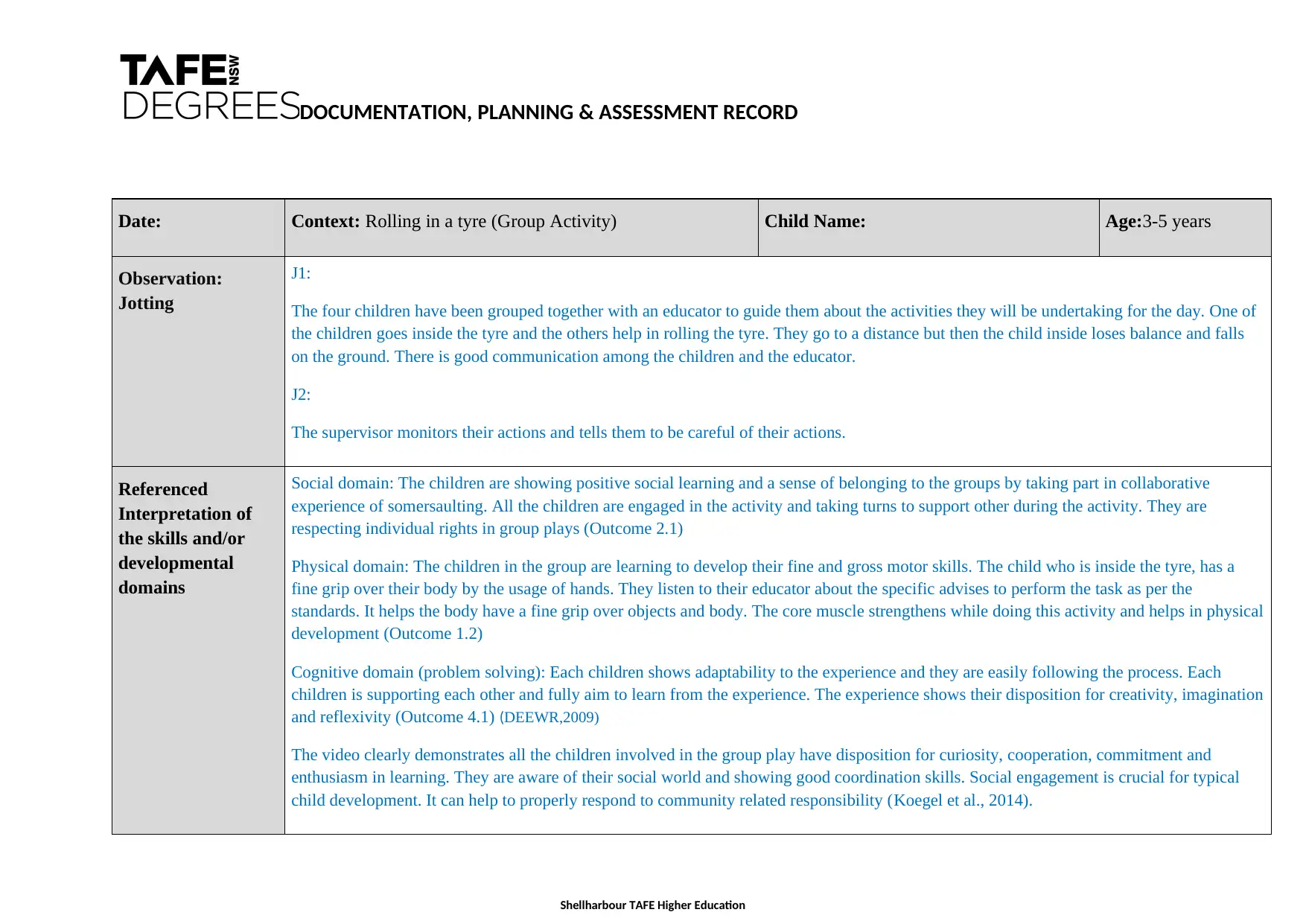
DOCUMENTATION, PLANNING & ASSESSMENT RECORD
Date: Context: Rolling in a tyre (Group Activity) Child Name: Age:3-5 years
Observation:
Jotting
J1:
The four children have been grouped together with an educator to guide them about the activities they will be undertaking for the day. One of
the children goes inside the tyre and the others help in rolling the tyre. They go to a distance but then the child inside loses balance and falls
on the ground. There is good communication among the children and the educator.
J2:
The supervisor monitors their actions and tells them to be careful of their actions.
Referenced
Interpretation of
the skills and/or
developmental
domains
Social domain: The children are showing positive social learning and a sense of belonging to the groups by taking part in collaborative
experience of somersaulting. All the children are engaged in the activity and taking turns to support other during the activity. They are
respecting individual rights in group plays (Outcome 2.1)
Physical domain: The children in the group are learning to develop their fine and gross motor skills. The child who is inside the tyre, has a
fine grip over their body by the usage of hands. They listen to their educator about the specific advises to perform the task as per the
standards. It helps the body have a fine grip over objects and body. The core muscle strengthens while doing this activity and helps in physical
development (Outcome 1.2)
Cognitive domain (problem solving): Each children shows adaptability to the experience and they are easily following the process. Each
children is supporting each other and fully aim to learn from the experience. The experience shows their disposition for creativity, imagination
and reflexivity (Outcome 4.1) (DEEWR,2009)
The video clearly demonstrates all the children involved in the group play have disposition for curiosity, cooperation, commitment and
enthusiasm in learning. They are aware of their social world and showing good coordination skills. Social engagement is crucial for typical
child development. It can help to properly respond to community related responsibility (Koegel et al., 2014).
Shellharbour TAFE Higher Education
Date: Context: Rolling in a tyre (Group Activity) Child Name: Age:3-5 years
Observation:
Jotting
J1:
The four children have been grouped together with an educator to guide them about the activities they will be undertaking for the day. One of
the children goes inside the tyre and the others help in rolling the tyre. They go to a distance but then the child inside loses balance and falls
on the ground. There is good communication among the children and the educator.
J2:
The supervisor monitors their actions and tells them to be careful of their actions.
Referenced
Interpretation of
the skills and/or
developmental
domains
Social domain: The children are showing positive social learning and a sense of belonging to the groups by taking part in collaborative
experience of somersaulting. All the children are engaged in the activity and taking turns to support other during the activity. They are
respecting individual rights in group plays (Outcome 2.1)
Physical domain: The children in the group are learning to develop their fine and gross motor skills. The child who is inside the tyre, has a
fine grip over their body by the usage of hands. They listen to their educator about the specific advises to perform the task as per the
standards. It helps the body have a fine grip over objects and body. The core muscle strengthens while doing this activity and helps in physical
development (Outcome 1.2)
Cognitive domain (problem solving): Each children shows adaptability to the experience and they are easily following the process. Each
children is supporting each other and fully aim to learn from the experience. The experience shows their disposition for creativity, imagination
and reflexivity (Outcome 4.1) (DEEWR,2009)
The video clearly demonstrates all the children involved in the group play have disposition for curiosity, cooperation, commitment and
enthusiasm in learning. They are aware of their social world and showing good coordination skills. Social engagement is crucial for typical
child development. It can help to properly respond to community related responsibility (Koegel et al., 2014).
Shellharbour TAFE Higher Education
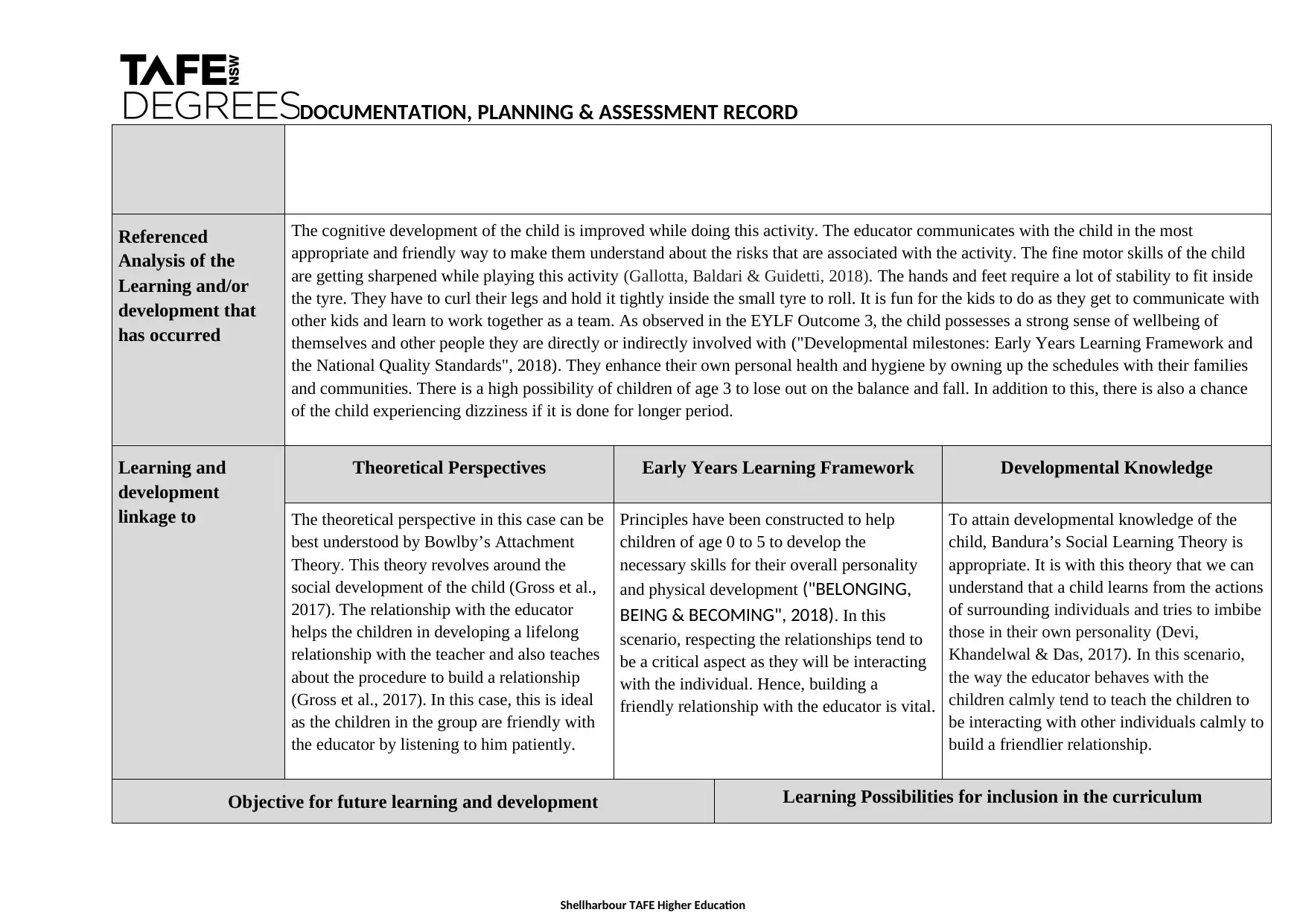
DOCUMENTATION, PLANNING & ASSESSMENT RECORD
Referenced
Analysis of the
Learning and/or
development that
has occurred
The cognitive development of the child is improved while doing this activity. The educator communicates with the child in the most
appropriate and friendly way to make them understand about the risks that are associated with the activity. The fine motor skills of the child
are getting sharpened while playing this activity (Gallotta, Baldari & Guidetti, 2018). The hands and feet require a lot of stability to fit inside
the tyre. They have to curl their legs and hold it tightly inside the small tyre to roll. It is fun for the kids to do as they get to communicate with
other kids and learn to work together as a team. As observed in the EYLF Outcome 3, the child possesses a strong sense of wellbeing of
themselves and other people they are directly or indirectly involved with ("Developmental milestones: Early Years Learning Framework and
the National Quality Standards", 2018). They enhance their own personal health and hygiene by owning up the schedules with their families
and communities. There is a high possibility of children of age 3 to lose out on the balance and fall. In addition to this, there is also a chance
of the child experiencing dizziness if it is done for longer period.
Learning and
development
linkage to
Theoretical Perspectives Early Years Learning Framework Developmental Knowledge
The theoretical perspective in this case can be
best understood by Bowlby’s Attachment
Theory. This theory revolves around the
social development of the child (Gross et al.,
2017). The relationship with the educator
helps the children in developing a lifelong
relationship with the teacher and also teaches
about the procedure to build a relationship
(Gross et al., 2017). In this case, this is ideal
as the children in the group are friendly with
the educator by listening to him patiently.
Principles have been constructed to help
children of age 0 to 5 to develop the
necessary skills for their overall personality
and physical development ("BELONGING,
BEING & BECOMING", 2018). In this
scenario, respecting the relationships tend to
be a critical aspect as they will be interacting
with the individual. Hence, building a
friendly relationship with the educator is vital.
To attain developmental knowledge of the
child, Bandura’s Social Learning Theory is
appropriate. It is with this theory that we can
understand that a child learns from the actions
of surrounding individuals and tries to imbibe
those in their own personality (Devi,
Khandelwal & Das, 2017). In this scenario,
the way the educator behaves with the
children calmly tend to teach the children to
be interacting with other individuals calmly to
build a friendlier relationship.
Objective for future learning and development Learning Possibilities for inclusion in the curriculum
Shellharbour TAFE Higher Education
Referenced
Analysis of the
Learning and/or
development that
has occurred
The cognitive development of the child is improved while doing this activity. The educator communicates with the child in the most
appropriate and friendly way to make them understand about the risks that are associated with the activity. The fine motor skills of the child
are getting sharpened while playing this activity (Gallotta, Baldari & Guidetti, 2018). The hands and feet require a lot of stability to fit inside
the tyre. They have to curl their legs and hold it tightly inside the small tyre to roll. It is fun for the kids to do as they get to communicate with
other kids and learn to work together as a team. As observed in the EYLF Outcome 3, the child possesses a strong sense of wellbeing of
themselves and other people they are directly or indirectly involved with ("Developmental milestones: Early Years Learning Framework and
the National Quality Standards", 2018). They enhance their own personal health and hygiene by owning up the schedules with their families
and communities. There is a high possibility of children of age 3 to lose out on the balance and fall. In addition to this, there is also a chance
of the child experiencing dizziness if it is done for longer period.
Learning and
development
linkage to
Theoretical Perspectives Early Years Learning Framework Developmental Knowledge
The theoretical perspective in this case can be
best understood by Bowlby’s Attachment
Theory. This theory revolves around the
social development of the child (Gross et al.,
2017). The relationship with the educator
helps the children in developing a lifelong
relationship with the teacher and also teaches
about the procedure to build a relationship
(Gross et al., 2017). In this case, this is ideal
as the children in the group are friendly with
the educator by listening to him patiently.
Principles have been constructed to help
children of age 0 to 5 to develop the
necessary skills for their overall personality
and physical development ("BELONGING,
BEING & BECOMING", 2018). In this
scenario, respecting the relationships tend to
be a critical aspect as they will be interacting
with the individual. Hence, building a
friendly relationship with the educator is vital.
To attain developmental knowledge of the
child, Bandura’s Social Learning Theory is
appropriate. It is with this theory that we can
understand that a child learns from the actions
of surrounding individuals and tries to imbibe
those in their own personality (Devi,
Khandelwal & Das, 2017). In this scenario,
the way the educator behaves with the
children calmly tend to teach the children to
be interacting with other individuals calmly to
build a friendlier relationship.
Objective for future learning and development Learning Possibilities for inclusion in the curriculum
Shellharbour TAFE Higher Education
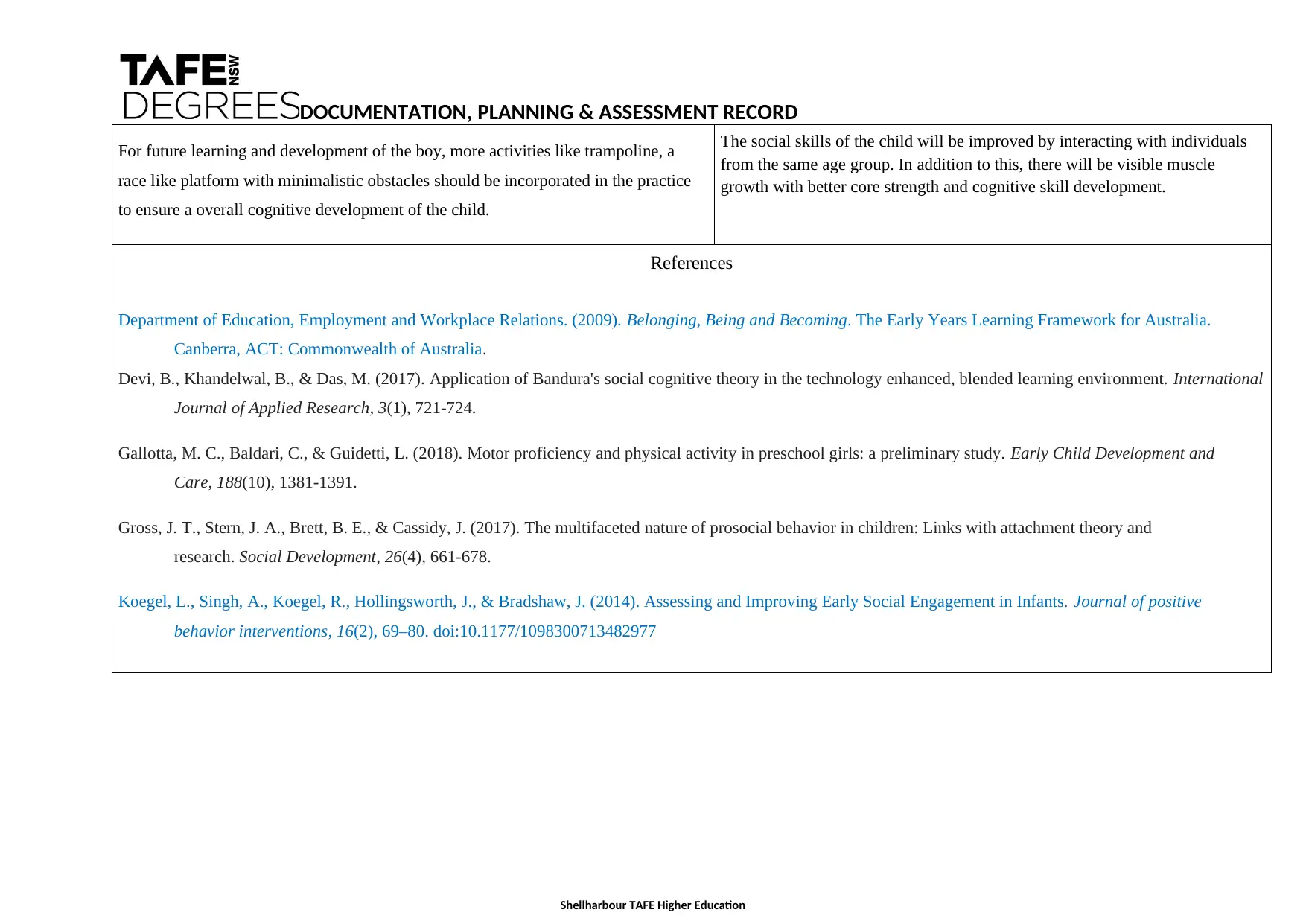
DOCUMENTATION, PLANNING & ASSESSMENT RECORD
For future learning and development of the boy, more activities like trampoline, a
race like platform with minimalistic obstacles should be incorporated in the practice
to ensure a overall cognitive development of the child.
The social skills of the child will be improved by interacting with individuals
from the same age group. In addition to this, there will be visible muscle
growth with better core strength and cognitive skill development.
References
Department of Education, Employment and Workplace Relations. (2009). Belonging, Being and Becoming. The Early Years Learning Framework for Australia.
Canberra, ACT: Commonwealth of Australia.
Devi, B., Khandelwal, B., & Das, M. (2017). Application of Bandura's social cognitive theory in the technology enhanced, blended learning environment. International
Journal of Applied Research, 3(1), 721-724.
Gallotta, M. C., Baldari, C., & Guidetti, L. (2018). Motor proficiency and physical activity in preschool girls: a preliminary study. Early Child Development and
Care, 188(10), 1381-1391.
Gross, J. T., Stern, J. A., Brett, B. E., & Cassidy, J. (2017). The multifaceted nature of prosocial behavior in children: Links with attachment theory and
research. Social Development, 26(4), 661-678.
Koegel, L., Singh, A., Koegel, R., Hollingsworth, J., & Bradshaw, J. (2014). Assessing and Improving Early Social Engagement in Infants. Journal of positive
behavior interventions, 16(2), 69–80. doi:10.1177/1098300713482977
Shellharbour TAFE Higher Education
For future learning and development of the boy, more activities like trampoline, a
race like platform with minimalistic obstacles should be incorporated in the practice
to ensure a overall cognitive development of the child.
The social skills of the child will be improved by interacting with individuals
from the same age group. In addition to this, there will be visible muscle
growth with better core strength and cognitive skill development.
References
Department of Education, Employment and Workplace Relations. (2009). Belonging, Being and Becoming. The Early Years Learning Framework for Australia.
Canberra, ACT: Commonwealth of Australia.
Devi, B., Khandelwal, B., & Das, M. (2017). Application of Bandura's social cognitive theory in the technology enhanced, blended learning environment. International
Journal of Applied Research, 3(1), 721-724.
Gallotta, M. C., Baldari, C., & Guidetti, L. (2018). Motor proficiency and physical activity in preschool girls: a preliminary study. Early Child Development and
Care, 188(10), 1381-1391.
Gross, J. T., Stern, J. A., Brett, B. E., & Cassidy, J. (2017). The multifaceted nature of prosocial behavior in children: Links with attachment theory and
research. Social Development, 26(4), 661-678.
Koegel, L., Singh, A., Koegel, R., Hollingsworth, J., & Bradshaw, J. (2014). Assessing and Improving Early Social Engagement in Infants. Journal of positive
behavior interventions, 16(2), 69–80. doi:10.1177/1098300713482977
Shellharbour TAFE Higher Education
1 out of 7
Your All-in-One AI-Powered Toolkit for Academic Success.
+13062052269
info@desklib.com
Available 24*7 on WhatsApp / Email
![[object Object]](/_next/static/media/star-bottom.7253800d.svg)
Unlock your academic potential
© 2024 | Zucol Services PVT LTD | All rights reserved.

